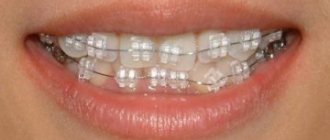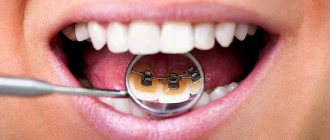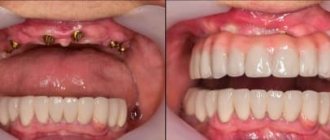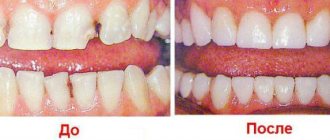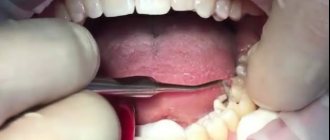Braces used in modern orthodontics are made from different materials. The most common designs are metal, but they can sometimes cause allergies, and are also too noticeable on the teeth. But sapphire and ceramic braces have high aesthetics when worn. What is the difference between these materials?
In this article
- Sapphire braces: what are they made of?
- Advantages of sapphire braces
- Disadvantages of sapphire braces
- Advantages of ceramic braces
- Cons of ceramic braces
- Sapphire and ceramic braces: differences
- Caring for sapphire and ceramic braces
Braces are produced from four types of materials:
- Metal. This is the most popular and budget type of orthodontic structures, and they are also the most durable. But metal systems have their own characteristics. Firstly, they are not advantageous in terms of aesthetics - they are very noticeable on the teeth, and secondly, some people are allergic to the presence of metal in the mouth.
- Ceramic. They are matched exactly to the color of your teeth enamel, so they are almost invisible when worn. Getting used to them occurs much faster than to metal ones, they are hypoallergenic and can even be prescribed to children. But ceramics also have their drawbacks - pigmentation from food products, fragility, high cost.
- Sapphire. They are made from artificially grown synthetic sapphires. They are completely transparent and almost invisible on the teeth, making them easier to care for. But sapphire systems have a significant disadvantage - quite high cost. This is the most expensive type of braces.
- Plastic. Plastic structures are almost invisible on the teeth - they are matched to the color of the enamel. Another advantage of braces made from this material is their affordable price. But they quickly become stained by food dyes, tea, coffee, and cigarettes. In addition, correction with their help is slower than with other types of braces due to the high coefficient of friction of the plastic.
Metal and plastic braces are more often chosen for installation than ceramic and sapphire braces due to their wide availability. But the last two types have incomparably higher aesthetics and other advantages. When choosing, a question often arises: what is the difference between sapphire braces and metal ones? Let's take a closer look at each type of structure to understand the difference.
Sapphire braces: what are they made of?
Of course, this type of braces is not made from natural stones - after all, real sapphire has a bright blue color. In addition, the cost of such systems would be affordable only to millionaires. Sapphires, which are used in dentistry, are specially grown from synthetic single crystals. In terms of hardness, they are second only to diamond or corundum, and are resistant to high temperatures. Thanks to these properties, artificial sapphires have found wide application in various industries: they are used instead of glass in the manufacture of protective screens for watches, cameras, gadgets, for substrates in microcircuits and other industrial needs. And in medicine - for the production of ophthalmic scalpels and artificial eye lenses, braces.
The first factor: when the doctor is used to working with certain braces
...Or he learned to work on ligature braces, then he becomes an adherent of the classic braces system. It happens that an orthodontist began his activity at the department as a resident, where everyone worked with a certain brace system, and he practically grew up on it. It can be difficult for a doctor to give up such preferences. But a professional and experienced orthodontist does not focus on one method of treatment, but knows and uses different techniques.
Advantages of sapphire braces
One of the main advantages of structures made from synthetic sapphires is their high aesthetics. Due to their transparency, they are almost invisible on the teeth, and metal ligatures are coated with a special white Teflon coating to enhance this effect. When exposed to sunlight, sapphire braces shimmer beautifully, turning into a stylish decoration - this is especially attractive to some people.
Designs made from synthetic sapphires are absolutely biocompatible with the oral mucosa and are hypoallergenic. They are carefully polished and do not cause discomfort when worn. Getting used to this type of braces occurs quite quickly - for example, metal ones require a longer adaptation.
Sapphire bracket systems, unlike plastic and ceramic ones, are practically resistant to staining, maintaining transparency throughout the entire treatment period. An important advantage of sapphire structures is that they are easier to care for, since stuck pieces of food are more visible.
Installation
Installation of sapphire structures has a number of difficulties.
Sapphire braces are placed on the outer surface of the teeth. Thanks to this, the patient maintains correct diction and microtrauma of the tongue is eliminated.
There are a number of contraindications when installing any braces systems:
- in the treatment of serious pathologies in the oral cavity;
- during the period of colds;
- in the first trimester of pregnancy.
The installation process of braces systems consists of the following steps:
- The orthodontist diagnoses the oral cavity and takes x-rays.
- Sanitation of the oral cavity is carried out (all teeth and possible inflammation of the gums are treated for caries).
- After this, the doctor takes dental impressions so that the design fits the patient as ideally as possible.
- Next, the dentist performs a professional teeth cleaning.
- After this, each tooth is treated with a special substance to weaken the enamel layer.
- To fix the braces, a composite composition is applied to the surface of the teeth. The installation of parts is selected individually for each individual tooth.
- After this, arches are threaded through the braces, which fix the correct position of the teeth.
The process of directly installing sapphire braces takes about 2 hours. It is painless and does not cause discomfort or discomfort. The main role when installing any braces is played by responsibility, accuracy and precision on the part of the orthodontist.
However, this method:
- prevents degradation of jaw bone tissue;
- prevents tooth wear;
- does not interfere with nasal breathing;
- prevents the appearance of individual facial defects during long-term wearing of orthodontic products.
When installed correctly, braces systems will serve patients for the entire term and will delight them with high results.
That's the whole process of installing braces systems.
Further success in correcting malocclusion depends only on the patients. To do this, you must comply with all the requirements and recommendations of the dentist and carefully monitor the condition of the installed structures.
Disadvantages of sapphire braces
There are not so many disadvantages of sapphire systems, but they still exist:
- The most significant disadvantage of braces made of this material is the rather high price. Their production is not mass-produced, unlike other types. In order to reduce treatment costs, sapphire braces can be installed only on the front teeth, and metal ones can be used for the rest.
- Sapphire braces, despite their fairly high hardness, are at the same time quite fragile: gnawing nuts while wearing them is definitely not recommended. If the lock breaks, the entire bracket must be replaced.
- The pressure that sapphire structures exert on teeth is not as great as that of metal ones, so they are not suitable for correcting complex malocclusion pathologies and correcting too crooked teeth. Treatment with their help will be longer and on average can take from 10 months to a year and a half or more.
- Installation of sapphire braces is only possible on snow-white teeth, and few can boast of this. If the enamel has a yellowish tint, it is better to choose ceramic or plastic braces in accordance with the natural color of the teeth.
Popular manufacturers
The leadership in the manufacture of sapphire bracket systems belongs to American manufacturers. They produce their products in a wide range, and constantly update their range. German companies are more painstaking in the production of sapphire braces and conduct clinical trials for a long time. Because of this, they are slightly behind their American colleagues. But their products are distinguished by high quality and affordable prices in Moscow.
Among the well-known manufacturers of sapphire bracket systems, it is worth highlighting the following companies:
- Ormco produces many orthodontic structures, but the most popular is the Inspire ICE braces. They are completely transparent and transmit both regular daylight and neon light well. They are characterized by high strength, durability and ease of wearing. These systems do not damage tooth enamel and can be easily and quickly removed if necessary;
- ZM has been producing equipment for correcting malocclusion for more than half a century. Their products have earned many prestigious awards and positive reviews from customers;
- American Orhodontics has been on the market for about 40 years and produces a wide range of all kinds of braces systems.
Advantages of ceramic braces
In many ways, sapphire and ceramic braces are quite similar, but ceramics still have their own characteristics:
- Ceramic braces are available in a wide variety of shades, so the doctor will be able to accurately match them to the natural color of the patient’s tooth enamel, even those very far from white.
- Systems made from this material are practically invisible on the teeth, so they do not cause any discomfort.
- Getting used to ceramics occurs in literally 1-3 days due to the ideal smoothness of the material.
- Ceramics are absolutely hypoallergenic and can be used for any category of patients.
- The composite material adheres very tightly to the surface of the teeth, as a result of which pieces of food cannot get under the braces.
Care instructions
Sapphire braces are transparent and plaque and food particles are very visible on them, so you need to clean your mouth after every meal. It is also worth giving up coffee, tea, chocolate, smoking, and reducing the consumption of coloring products.
Otherwise, caring for the sapphire system is the same as for the others:
- brushing your teeth 2-3 times a day with paste and brush, using mono-beam and V-shaped brushes,
- using an irrigator, dental floss, brushes during each home hygiene session,
- Regular visits to the dentist for professional cleaning.
Cons of ceramic braces
Like sapphire, ceramic braces are quite expensive. They are more expensive than metal or plastic systems, but still cheaper than sapphire. Partial installation of ceramic structures is also possible: the orthodontist attaches them only to the visible part of the dental row, and uses metal for the remaining teeth.
Another disadvantage of ceramics is the tendency to stain when consuming certain foods, tea, coffee, and cigarettes. Their installation is not recommended for heavy smokers and coffee fans who are not going to give up their habits. While wearing it, it is advisable to refrain from eating beets, chocolate, and berries, which can stain the ceramics.
Ceramic braces are worn longer than metal ones - in terms of impact they are in second place after stainless steel structures.
In what cases are braces placed?
The very essence of such treatment is the forced alignment of the dentition - this is the first thing that those who doubt the need to install them need to know about braces. Only these systems guarantee a visual effect within 10–12 months and can work even in complex cases of twisted or crooked teeth in adults.
In what cases are braces placed? Common indications for installation are:
- broken bite;
- facial asymmetry;
- presence of tooth gaps;
- crooked or twisted teeth;
- previous jaw injuries or other pathologies that provoked temporomandibular anomalies (crunching and characteristic discomfort may be present when chewing);
- unevenness of the dentition - protruding or recessed individual teeth.
There are different types of braces for children and adults. Their choice is always a joint work of the treating orthodontist and the patient.
Whichever option you choose, our specialists will conduct a detailed consultation taking into account the goals and individual priorities of each patient. Depending on which teeth the braces are placed on (type of malocclusion), we will help you choose the best option, prepare you for the procedures, and carry out all installation work without discomfort, pain, or fear.
Sapphire and ceramic braces: differences
These two types are quite similar in technical characteristics: they are very aesthetic when worn, almost invisible in the mouth. Ceramic and sapphire braces have important advantages over metal ones, such as hypoallergenicity and quick adaptation. But still, there are several differences between ceramic and sapphire braces:
- Ceramic systems are more budget-friendly than sapphire ones.
- Ceramic braces are considered stronger than those made from synthetic sapphires.
- Orthodontic structures made from sapphires are installed only on naturally white teeth, and ceramics can be used for enamel of any shade.
In general, it cannot be said that there is too much difference between sapphire and ceramic braces. Both types of braces are characterized by high aesthetics and effectiveness, unless we are talking about too complex cases. The orthodontist will help you decide on the choice of material: he will take into account the complexity of the pathology, the condition of the patient’s teeth, and other details.
Price
The price of sapphire braces in Moscow depends on various factors. On average, their cost varies from 25,000 rubles and above. If all braces are made of sapphire, then their cost increases significantly. If sapphires are installed only in visible areas, and ceramics or metal are used on distant teeth, this significantly reduces the cost of the structure. Before choosing sapphire braces, study information about them on the Internet, read people's reviews and compare the cost of products in Moscow.
Pros of metal braces
The very first braces systems were made from dental steel. Even today they remain one of the most reliable and effective tools for correcting malocclusion. The main advantages of these systems include:
- Exceptional strength of braces. Metal braces are the most durable of all existing systems. Dental steel does not break, system elements do not fail unless you specifically try to damage them, and also do not deteriorate - do not oxidize, do not change their color;
- They are considered the most effective braces systems that can correct even a complex bite. Compared to other existing systems, they cope with assigned tasks an order of magnitude faster;
- No long rehabilitation period required;
- Metal braces are the most budget-friendly solution for straightening teeth and correcting bites;
- Ease of installation and removal is another advantage of this system.
This is why metal braces are often chosen by parents to correct the bite of children and adolescents. Reliable, efficient and inexpensive.
How is the archwire attached to the braces?
The metal arch is connected to the braces in two possible ways. The first is with the help of special ligatures. The second method of fastening occurs due to special locks on the surface of the braces plates.
Braces with a ligature fastening system are “Inspire ICE” and “Radiance”. Such braces have a special groove in the system - it is into this that the metal arch is inserted. The arch sits firmly in the groove thanks to special ligatures - these include elastic bands or orthodontic wire.
It doesn’t matter what color the rubber bands are. They are colored, colorless or white. If you have white gum, you should be careful with drinking drinks that have a coloring effect. This is black, strong tea, red wine, coffee. During a routine inspection, a specialist will replace them. Typically, rubber bands are replaced monthly.
If the rubber bands on your braces are white, then you should avoid strong tea and coffee, as well as red wine.
The non-ligature fastening system includes “Damon clear”. Ligatures are not used with this fixation system. These braces have a surface that is distinguished by a special lock, which snaps into place immediately after the metal arc enters the groove. Another name for such braces is self-ligating. Their cost is higher.
Ligature-free braces are quite fragile. They cost more. The treatment period with them becomes longer. The mucous membranes of the cheeks and lips may suffer when wearing braces with this fixation system. Manufacturers see the advantages of such braces in the fact that you do not need to go to the orthodontist with them as often as with ligature ones. With them, you can achieve high efficiency in moving teeth to the right place.
Important ! The risk of complications with them is low.
Based on the type of fixation of the archwire to braces, two types can be distinguished - active and passive. The first type - the arc is firmly fixed in the groove, and it cannot move. Passive type - the arc is in weak contact with the groove, so sliding along it is allowed. In therapy, these types are used alternately, replacing each other. This must be done to correct various inclinations and rotations of the teeth, when expanding the dentition.
The arc can be fixed in different ways
Using ligature braces, you can easily change the fixation, either weakening it or strengthening it. This cannot be done with non-ligature braces: all because of a special lock, which, according to the type of fixation, can be active (the arch is tightly fixed and does not move) and passive (the arch slides along the groove, but the lock prevents it from jumping out of it).
- White braces
Classes into which ceramic products are divided
There are two classes in total. These are polycrystalline and monocrystalline braces. The polycrystalline system is most in demand due to its unique ability to match the color of teeth. The only negative is the dullness of the coating. This coverage is not suitable for every patient.
Monocrystalline systems are quite fragile. The color is more transparent than the previous version and is comfortable to wear. They completely match the color of tooth enamel. They are easier to damage, but are still more durable.
Polycrystalline and monocrystalline braces

